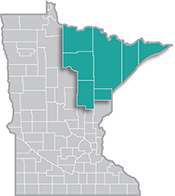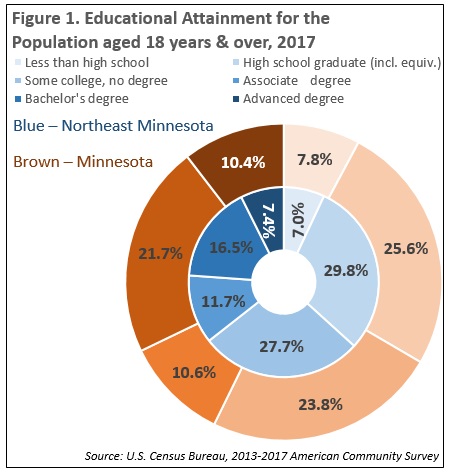 Home to the state's second-largest metro, the Northeast Region has a strong industrial sector, tied largely to the area's abundant natural resources.
Home to the state's second-largest metro, the Northeast Region has a strong industrial sector, tied largely to the area's abundant natural resources.
Most of the manufacturing base centers on mining and forest products industries. More than half of the sector's employment is in paper and machinery manufacturing.
Want the freshest data delivered by email? Subscribe to our regional newsletters.
1/31/2019 4:00:00 PM
Cameron Macht
Minnesota is known for its well-educated workforce, where more than 92 percent of adults have at least a high school diploma, two-thirds (66.6%) have at least some college experience, and almost 43 percent have a college degree: either an associate, bachelor’s, or advanced degree (Figure 1). Northeast Minnesota has slightly lower educational attainment rates overall than the state, but more detailed data show that the gap is closing with younger age groups.

Due to the presence of several colleges and universities, Northeast Minnesota has a large student population. According to U.S. Census data, almost one in every five 18- to 24-year-olds in the region already have a college degree, including 8.5 percent who have an associate degree and 9.5 percent with a bachelor’s degree or higher. That was in line with the state rate, where 19.7 percent of 18- to 24-year-olds have a degree already.
What’s more, Northeast Minnesota actually has a higher percentage of 18- to 24-year-olds with some college experience, but no degree yet. Almost half (47.2%) of young adults in the region have some college, compared to 40.8 percent statewide. In sum, 65.3 percent of 18- to 24-year-olds in the Arrowhead have at least some college experience, compared to 60.5 percent in Minnesota.
Likewise, Northeast also has a higher percentage of 25- to 44-year-olds with some college experience, but no degree when compared to the state; but again a slightly lower percentage of residents with a college degree. When combined, 72.9 percent of 25- to 44-year-olds in the Arrowhead have at least attended college and/or earned a degree, compared to 74.5 percent statewide.
In contrast, the oldest age group – which likely didn’t have the same access or demand for higher education as young adults do now – had much lower educational attainment rates. Just over half (50.4%) of people aged 65 years and over in the region stopped their education with a high school diploma or less, including one in every nine residents who did not graduate from high school. Part of the reason the region’s educational attainment looks lower than the state is that a much larger percentage of the population is in the 65 years and over age group, which has lower educational attainment (Table 1).

Contact Cameron Macht at 320-441-6596.